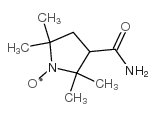Organ specific mapping of in vivo redox state in control and cigarette smoke-exposed mice using EPR/NMR co-imaging.
George L Caia, Olga V Efimova, Murugesan Velayutham, Mohamed A El-Mahdy, Tamer M Abdelghany, Eric Kesselring, Sergey Petryakov, Ziqi Sun, Alexandre Samouilov, Jay L Zweier
文献索引:J. Magn. Reson. 216 , 21-7, (2012)
全文:HTML全文
摘要
In vivo mapping of alterations in redox status is important for understanding organ specific pathology and disease. While electron paramagnetic resonance imaging (EPRI) enables spatial mapping of free radicals, it does not provide anatomic visualization of the body. Proton MRI is well suited to provide anatomical visualization. We applied EPR/NMR co-imaging instrumentation to map and monitor the redox state of living mice under normal or oxidative stress conditions induced by secondhand cigarette smoke (SHS) exposure. A hybrid co-imaging instrument, EPRI (1.2 GHz)/proton MRI (16.18 MHz), suitable for whole-body co-imaging of mice was utilized with common magnet and gradients along with dual EPR/NMR resonators that enable co-imaging without sample movement. The metabolism of the nitroxide probe, 3-carbamoyl-proxyl (3-CP), was used to map the redox state of control and SHS-exposed mice. Co-imaging allowed precise 3D mapping of radical distribution and reduction in major organs such as the heart, lungs, liver, bladder and kidneys. Reductive metabolism was markedly decreased in SHS-exposed mice and EPR/NMR co-imaging allowed quantitative assessment of this throughout the body. Thus, in vivo EPR/NMR co-imaging enables in vivo organ specific mapping of free radical metabolism and redox stress and the alterations that occur in the pathogenesis of disease.Copyright © 2011 Elsevier Inc. All rights reserved.
相关化合物
| 结构式 | 名称/CAS号 | 分子式 | 全部文献 |
|---|---|---|---|
 |
3-氨基甲酰-2,2,5,5-四甲基-1-吡咯烷氧基
CAS:4399-80-8 |
C9H17N2O2 |
|
Hepatic reduction of carbamoyl-PROXYL in ferric nitrilotriac...
2012-01-01 [Biol. Pharm. Bull. 35(7) , 1035-40, (2012)] |
|
Monitoring redox-sensitive paramagnetic contrast agent by EP...
2008-01-01 [J. Magn. Reson. 190(1) , 105-12, (2008)] |
|
Non-invasive analysis of reactive oxygen species generated i...
2004-02-01 [Free Radic. Res. 38(2) , 147-55, (2004)] |
|
In vivo detection of gastric cancer in rats by electron para...
2004-09-15 [Cancer Res. 64(18) , 6495-502, (2004)] |
|
Comparison of stable nitroxide, 3-substituted 2,2,5,5-tetram...
2006-04-01 [Free Radic. Biol. Med. 40(7) , 1170-8, (2006)] |